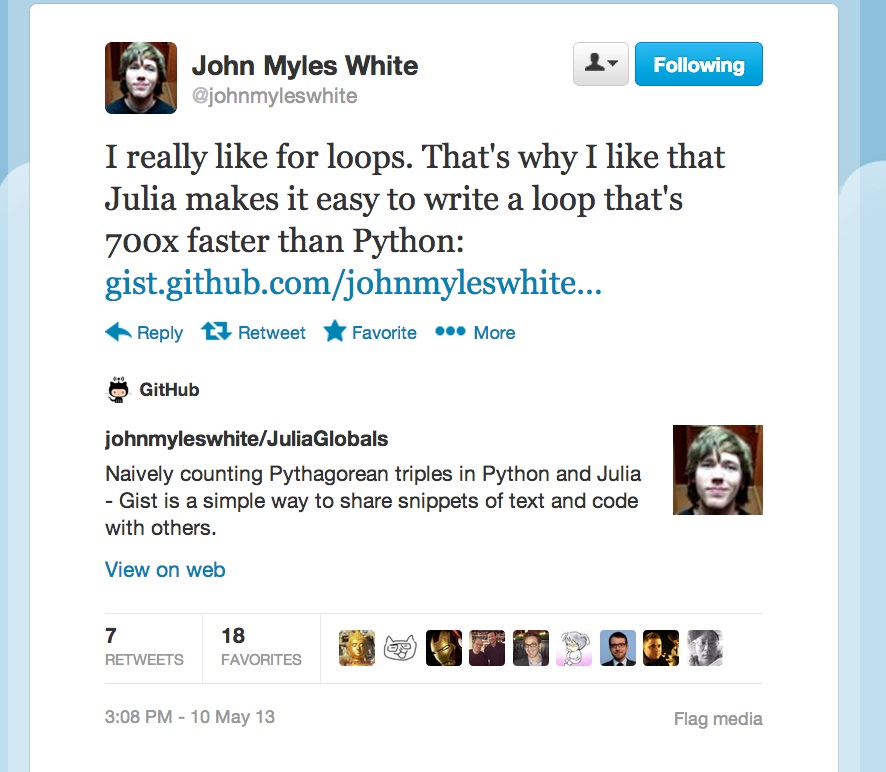I’ve seen the best minds of my generation destroyed by Matlab …
(Note: this is very quick and not well thought out. Mostly a conversation starter as opposed to any real thesis on the subject.)
This post is a continuation of a Twitter conversation here, started when John Myles White poked the hornets’ nest. (Python’s nest? Where do Pythons live?)

The gist with John’s code is here.
This isn’t a very thoughtful post. But the conversation was becoming sort of a shootout and my thoughts (half-formed as they are) were a bit longer than a tweet. Essentially, I think the Python performance shootouts—PyPy, Numba, Cython—are missing the point.
The point is, I think, that loops are a crutch. A 3-nested for loop in Julia that increments a counter takes 8 lines of code (1 initialize counter, 3 for statements, 1 increment statement, 3 end statements). Only one of those lines tells me what the code does.
But most scientific programmers learned to code in imperative languages and that style of thinking and coding has become natural. I’ve often seen comments like this:

Which I think simply equates readability with familiarity. That isn’t wrong, but it isn’t the whole story.
Anyway, a lot of the responses to John’s code were showing that, hey, you can get fast loops in Python, with either JITing (PyPy, Numba) or Cython. So here are my thoughts:
1. Cython is great. I’ve used it with great success myself. But Julia gives me fast loops while keeping the dynamic typing; i.e., I’m still writing in Julia. Cython is a manifestation of what the Julia developers call the “two-language problem.” My programmer-productivity happens in the slow, dynamic language, and I swap to a more painful language for critical bottlenecks and glue the two together. Cython is a more pleasant manifestation of the problem, especially since it lets you evolve in an exploratory, piece-meal way from your first language to your second language. But you still end up with code that is nice dynamic-typing and abstractions on the outside; gross static typing and low-level imperative stuff on the inside. (And Cython examples are often clean and simple, but the code can get hairy very quickly.)
2. One of the nice things about the slow for loops in Python and R is that they force you to think about other ways to express your problem. R and Python programmers start thinking about how they can exploit arrays and other ADTs, and higher-order functions to express they’re problem. Avoiding the loop performance hit is the first reason, but then many of them start to realize they like their code better this way. The adjustment is hard at first, but once you get their, it’s hard to go back.
Forget about the Numpy, PyPy, Cython solutions to John’s problem. I think it’s safe to say his original pure Python code would be considered pretty un-Pythonic, to the extent that’s a thing. Python programmers are discouraged from that style of writing-C-in-Python, for both performance reasons, and conceptual reasons. Python programmers just think the alternatives (e.g. list comprehensions) are more expressive and maintainable. They’re not avoiding for loops because they’re slow: they don’t want to write for loops.
Maybe Julia is the answer to this problem. Since list comprehensions, higher-order-functions (applies, maps, etc.) wrap imperative loops, and Julia loops are fast, then these things can be written in Julia and be fast.
But that requires some thought about how Julia devs want Julia programmers to program. Julia is great and really promising, and it’s got an opportunity to let scientific programmers really raise their game. But I’d hate the big pitch for Julia to be: hey, you can write fast loops! And it would basically become a refuge for people who never learned to properly code R and are are fed up with slow loops, or for Matlab guys who’s licenses ran out.
Comments